Japan is one of the most beautiful and mysterious countries to visit in Asia, seamlessly merging its ancient history with futuristic technology. Mount Fuji is the country’s most instantly recognisable natural landmark and one that Japan is famous for. Another icon of Japan is its cherry blossoms, which when in season draws thousands of visitors to view these delicate pink flowers in full bloom.
Japan is also famous for its cuisine. Sushi is prepared with care by expert hands offering diners only the best and freshest fish. Some sushi restaurants offer exclusive and intimate black-tie dining experiences, while others capitalise on the fast-paced nature of the cities with conveyor-belt sushi prepared by highly skilled robots. For a truly authentic and local dining experience visit an izakaya, a small and intimate bar serving drinks and snacks such as yakitori chicken.
Experience the throngs of people in Tokyo, Japan’s capital city, and immerse yourself in the sheer volume of technology surrounding you. Everything from 3D and interactive billboards to robot cafes and even giant moving sculptures of Gundam robots and Godzilla can be found here. For a more relaxed pace, head to Japan’s northern island of Hokkaido where nature is king. Hokkaido is known for its breathtaking natural beauty nestled among six national parks. Here you will find hot springs, dense forests, mountains and volcanoes. Japan is a truly magical country that encourages the preservation of its ancient culture while welcoming the exciting technological advancements of the future. Here are 15 things Japan is famous for.
Contents
What is Japan known for?
1- Ramen
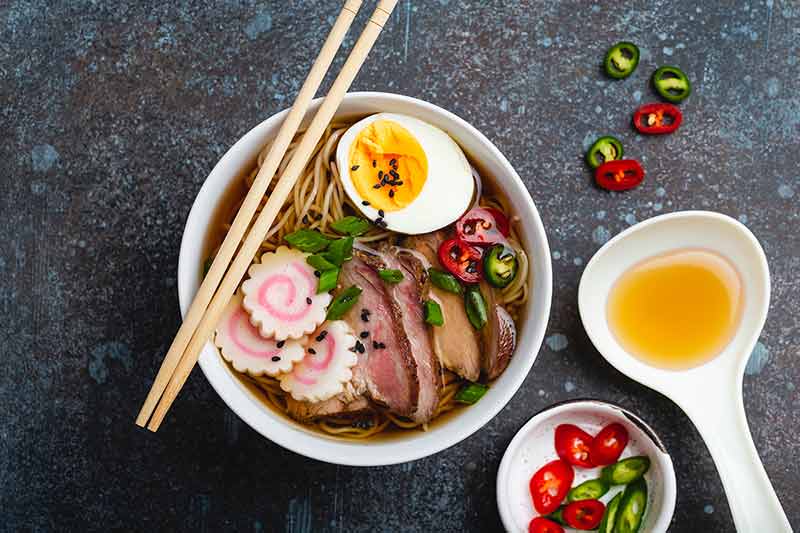
One of the most well-known Japanese dishes is Ramen, a noodle dish typically made from a rich soup base, noodles, seasonal vegetables and meats, fish cakes and soft boiled eggs.
One of the most popular variations of ramen is tonkotsu, a ramen made using a creamy broth made from pork and served with delicious chāshū pork, green onions and a delicate soft boiled egg.
Ramen is a highly adaptable dish, with each region offering different specialities, noodle varieties and of course toppings.
There are options that are pork-free, vegetarian and vegan available allowing everyone to try this warming and satisfying dish.
Whether you choose to go to an intimate restaurant seating only a handful of people around the bar overlooking ramen chefs, or to visit a more bustling location where you order ahead on a machine, ramen is a must try dish when in Japan.
2- Anime
Anime refers to animations made in Japan, and its influence on Japanese culture is clear throughout its towns and cities.
The earliest anime films were made in 1912, with significant developments to the technology used to produce these films in the 1940s allowing them to become more widespread.
Japanese anime became mainstream in the 1980s with the likes of Gundam and Dragon Ball seeing widespread popularity.
Perhaps one of the most beloved Japanese anime houses, Studio Ghibli, was founded in 1985 and has gone on to produce blockbuster anime movies including Spirited Away, Princess Mononoke and My Neighbour Totoro.
Studio Ghibli even has its own park designed to represent the world of Studio Ghibli, its characters and its magical landscapes.
In Japan you can find references to anime everywhere, from billboard advertisements to noodles and soft drinks boasting famous anime characters.
There are also cafes dedicated to anime characters and series where dishes are served to look like your favourite characters, and of course there are plenty of opportunities for quirky anime-themed souvenirs.
3- Mount Fuji
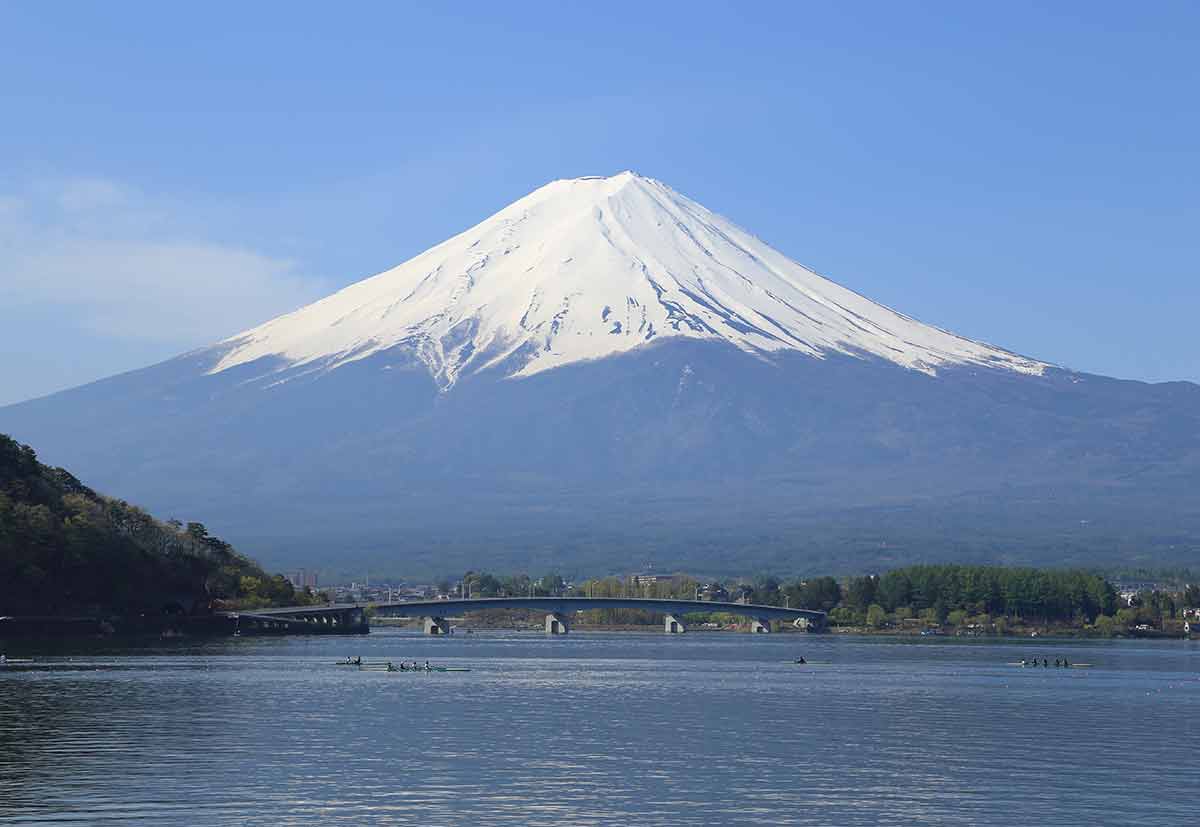
Mount Fuji is considered a sacred symbol by the people of Japan and an active stratovolcano with a summit at 3776 m (12,389 ft).
Located on the island of Honshū, Mount Fuji is considered sacred as it is the spiritual home for the Japanese people.
This spirituality is clear from the number of shrines and torii gates surrounding the base of Mount Fuji.
Many Japanese artists, writers and poets have dedicated their lives to try to capture the beauty of Mount Fuji including Katsushika Hokusai.
Hokusai, who lived fro 1760 till 1849, decided at the age of 70 to dedicate the rest of his life to capturing Mount Fuji in all seasons, and from all aspects.
This beautiful collection is known as Thirty-six Views of Mount Fuji and includes the famous ‘The Great Wave; which depicts the mountain in the background.
4- Strange Cafes
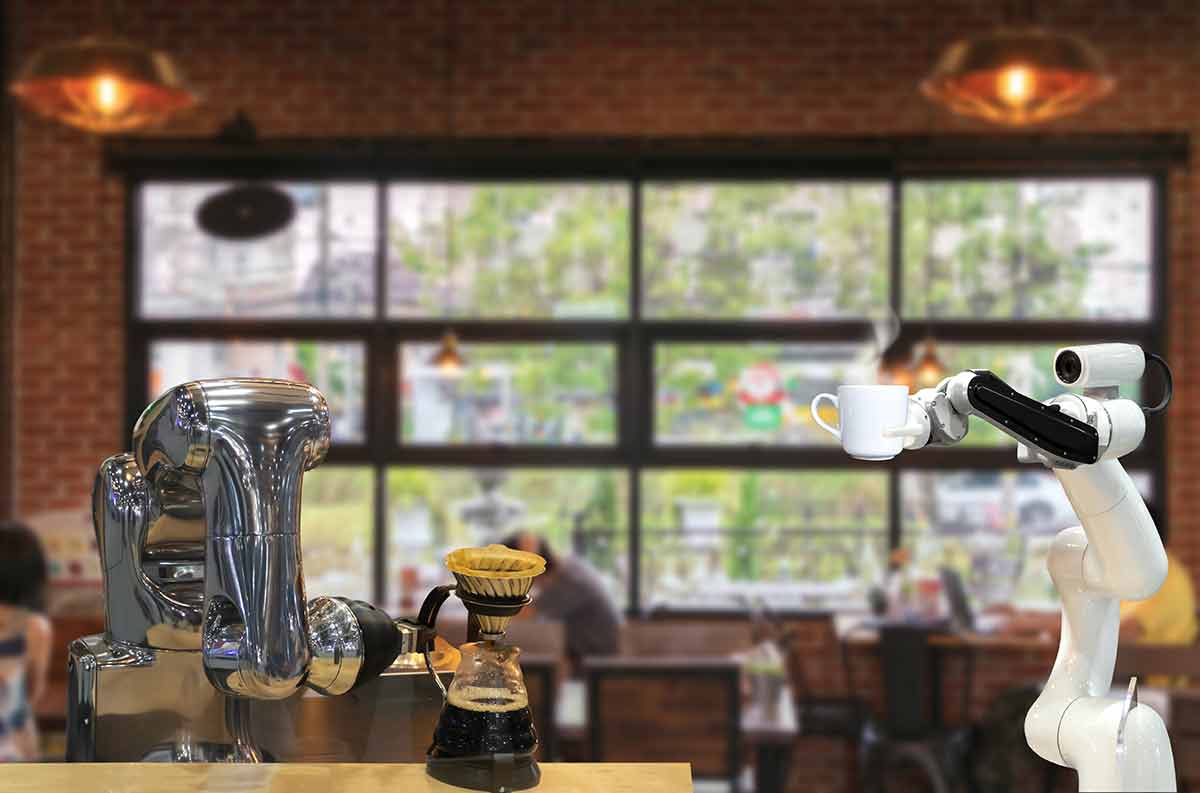
Japans largest cities are home to many unique and unusual cafes.
While cat cafes are becoming more and more popular in the west, Japan has taken a more creative outlook on this growing trend.
Get up close with a variety of animals in one of Tokyo’s many animal-themed cafes.
In the capital it is possible to have your morning coffee with owls, reptiles, hedgehogs and even goats.
For those looking for something a little more futuristic, why not try dining at a robot restaurant where your surroundings are neon, rave music is pumped in over speakers and you are served by robots.
For a cuter and more kawaii experience head to a cafe that specialises in 3D latte art, or visit one that is themed like your favourite anime series.
Across Tokyo there are cafes dedicated to Snoopy, Pokemon and even classic English book character Peter Rabbit.
Studio Ghibli fans can rejoice at the cosy Shiro-Hige Cream Puff Factory, where in a cafe surrounded by Studio Ghibli memorabilia visitors can enjoy a Totoro shaped cream puff.
5- Cherry Blossom
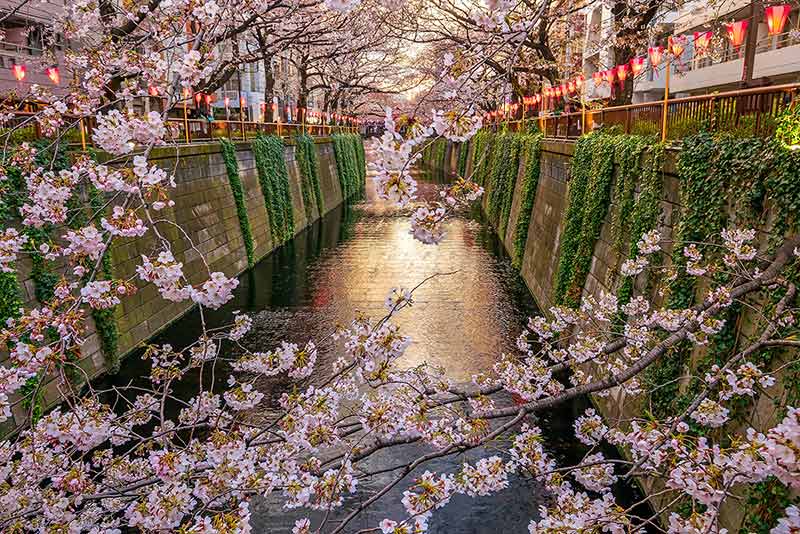
Cherry blossom, or Sakura as it is known in Japan, is a key part of Japanese culture and one that signals the start of spring.
Across Japan between March and April the cherry blossom is in full bloom, drawing thousands of visitors to experience this natural phenomena.
The viewing of cherry blossom is known as hanami, and is so influential on Japanese culture that it makes the news, and there are many festivals and events held during the season.
During cherry blossom season expect to see locals enjoying picnics in the parks under cherry trees, tea ceremonies in beautiful surroundings and food stalls celebrating the bounty of the season.
Food is themed during cherry blossom season, so look out for sakura-themed drinks from local cafes to big chains like Starbucks and McDonalds, as well as dainty bento boxes filled with spring treats.
One of the best places to see cherry blossom in Japan is Yoshino, Kansai, where thousands of trees cover the surrounding Kii mountains.
For more about Japan, read:
- 20 Incredible Landmarks in Japan
- 20 Best Beaches In Japan
- 25 Things To Do In Tokyo At Night
- 25 Landmarks In Tokyo
- A Guide To Winter In Japan
- 50 Things To Do In Japan
- Japan Itinerary (10 days)
- Where To Stay In Tokyo
- Osaka Itinerary
- Nagoya Itinerary
- Where To Stay In Nagoya
- 12 Things To Do in Takayama
- How To Use The Toilets In Japan
- Osaka Itinerary
- 20 Things To Do In Osaka At Night
- Where To Stay In Osaka
- 20 Things To Do In Hiroshima
- Where To Stay In Hiroshima
- 20 Things To Do In Yokohama
- 15 Things Japan Is Famous For
- 20 Things To Do In Kamakura
- 20 Things To Do In Nagano
- 20 Day Trips From Tokyo
- 3 Day Trips From Osaka
- The Most Beautiful Japan Tourist Spots
- Hakuba Hotels
- Hakuba Ski Resort
- Japanese Onsen Tips
- Where To Stay In Kyoto Like A Local
- Arashiyama Monkey Park
- Eating and Drinking Matcha
- Amanemu Review
- 20 Japanese Drinks
- 20 Things To Do In Kyoto At Night
- 20 Japanese Cities
- 20 Things To Do In Fukuoka
- Where To Stay In Fukuoka
- 20 Things To Do In Nara
- 20 Things To Do In Hakone
- 20 Things To Do In Sapporo
- Where To Stay In Sapporo
- 20 Things To Do In Kanazawa
- 20 Things To Do In Okinawa
- 20 Things To Do In Sendai
- 20 Things To Do In Saitama
6- Technology
Since the 1960s Japan has been synonymous with technology and technological advancements.
In Tokyo this immersion in technology is abundantly clear in the district of Akihabara.
Towering over you are buildings covered in brightly lit up screens and billboards, all housing some of the largest technology megastores in the country.
Throughout Japan it is possible to interact with technology at every opportunity.
Some hotels have robots at the check-in desks in the form of dinosaurs offering you guidance on how to check in and what facilities the hotels have.
In train stations, yet more robots offer customer service and tourist information in a variety of languages.
One of the most famous robots to come out of Japan is Honda’s humanoid robot ASIMO.
ASIMO can be seen in action at the Miraikan National Science Museum as he completes a range of tasks including walking, running and pouring juice.
7- Samurai
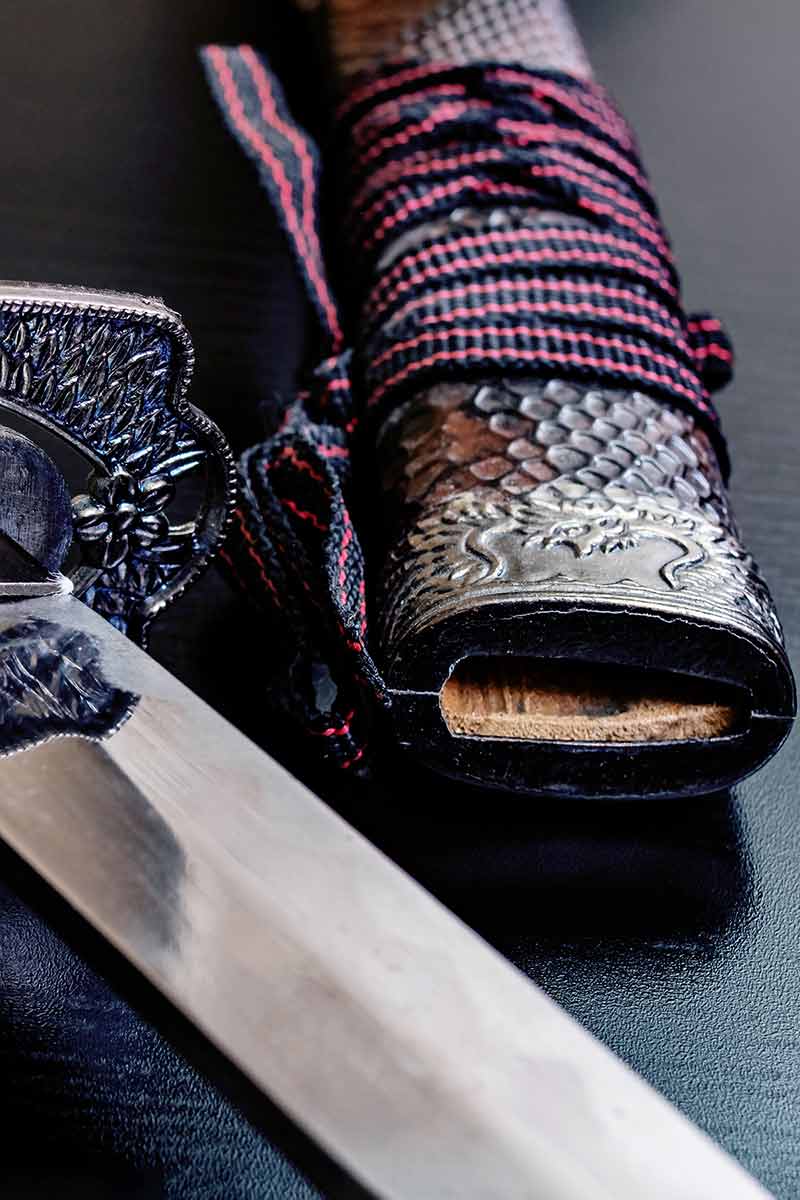
Samurai date from the 12th century and were prominent in Japan until their abolishment in the 1870s.
Samurai were a group of elite warriors who eventually were within the highest social caste during the Edo Period.
In Japan samurai are known for their strict moral code of honour and elaborate traditional dress.
The samurai operated on a strict code known as bushido meaning ‘way of the warrior’, and with its basis in Zen Buddhism, the samurai used their strength to maintain peace across Japan.
The katana, a carefully handcrafted sword produced by expert sword smiths, were carried by the samurai and were believed to hold the samurai’s soul.
As a result, authentic samurai katana swords today are seen as highly valuable and are treated with the upmost respect.
Samurai weren’t just male warriors however, as many female samurai known as ‘Onna-Bugeisha’ were fierce fighters who protected their family during times of war.
8- Geisha
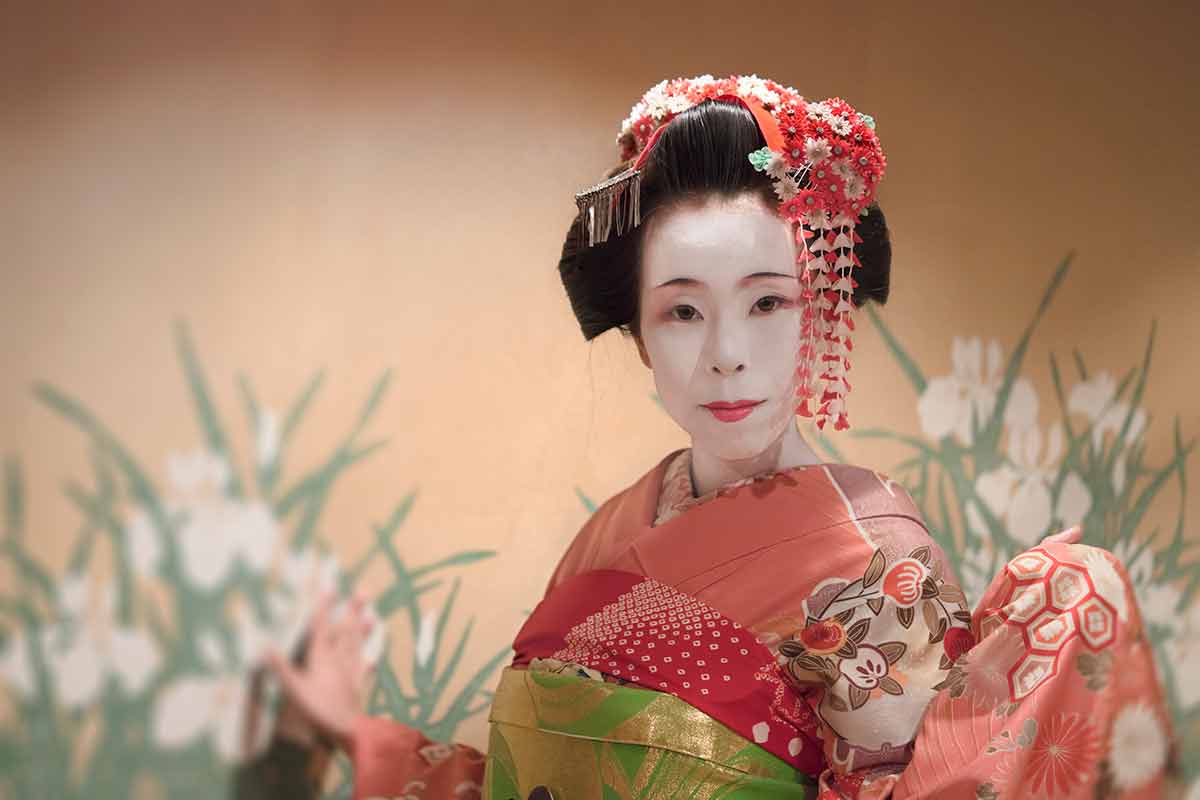
Japan’s geisha are recognisable all over the world over for their distinctive hairstyles, pale faces and red lips, often seen in traditional dress and accompanied with fans.
Since the 17th century geisha have been entertaining people with a variety of traditional art, music, dance and song, as well as performing tea ceremonies.
The best place in Japan to see geisha and experience their culture is in Kyoto where around 100 geisha work in traditional tea houses.
Traditionally a geisha will begin their journey aged 15 where they will learn hospitality skills and some traditional arts, before developing a greater skillset ready to entertain guests.
Despite the growing desire for futuristic entertainment, bars and unique restaurants, geisha culture is still popular in Japan, however it is expensive to spend some time in the company of these talented and hospitable women.
9- Vending Machines
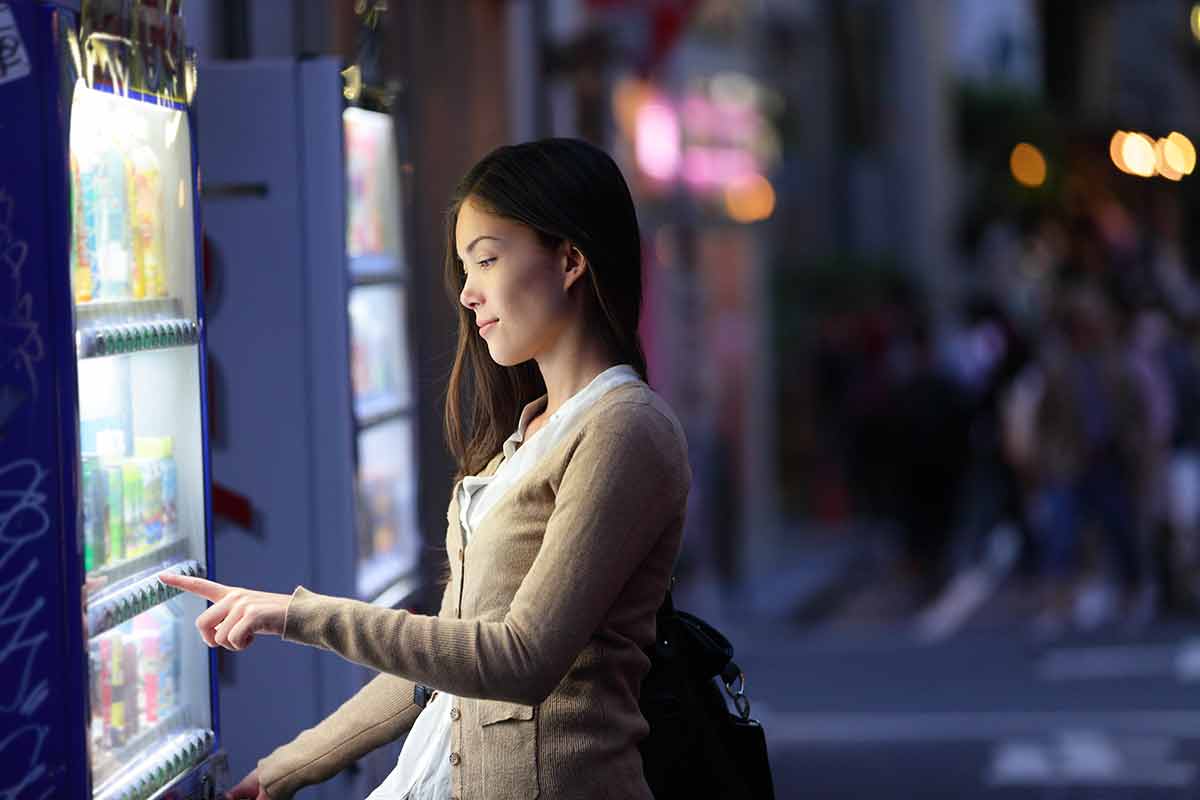
While vending machines can be found everywhere, from hotel lobbies to train station platforms, no other country approaches this quite like Japan.
Across Japan it is possible to find stores completely full of vending machines, with no in-person staff available.
Japan has vending machines selling drinks, however many offer unique twists such as machines offering water or milk from different parts of the country, to those selling everything from iced coffee and juice to beer.
Food from vending machines can include simple snacks, cans of warm oden soup, thickly sliced and generously filled sandwiches and even tins filled with bread.
Taking purchasing a drink from a vending machine further is AI Sakura-san, a vending machine found in train stations with an AI helper who uses facial recognition to help you choose a drink while you wait for a train; she can even provide you with information about the station and train times!
Some of the most popular vending machines are ‘gacha-gacha’ where small capsule toys can be purchased.
There are even vending machines offering mystery items varying in price, with everything from small trinkets to gadgets hidden inside.
10- Torii Gates
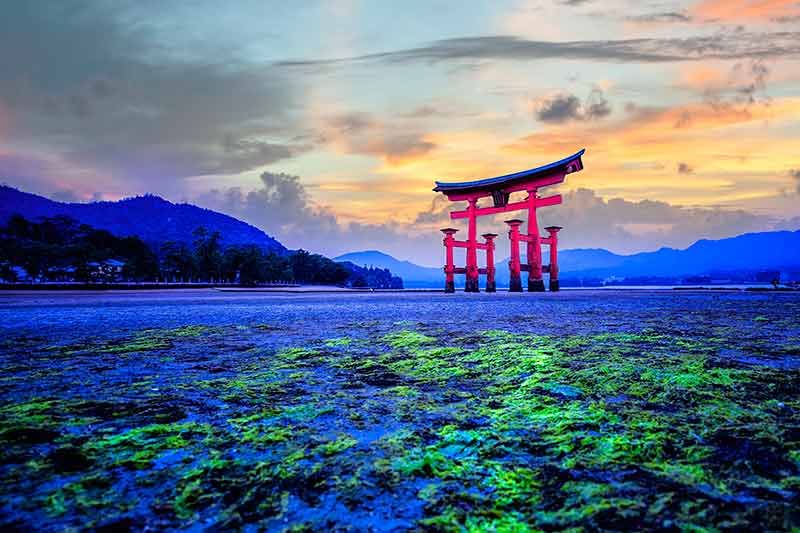
Torii Gates are traditionally found around the entrances to Shinto shrines or inside their boundaries.
Crossing through these gates symbolises a transition from the everyday to the sacred.
One of the most famous Torii gates can be found at Itsukushima Shrine in Miyajima.
This shrine is famous as it is completely surrounded by water and appears to be floating.
Another well-known Torii gate location is at Fushimi Inari Shrine in Kyoto, where the shrine can be reached following through a walk through thousands of traditional bright red Torii gates featuring Japanese writing.
To see both the beauty of shrines and Torii gates and Mount Fuji, head to Arakura Sengen Shrine in Yamanashi.
This shrine was founded in 705 and is surrounded by cherry trees making it a beautiful springtime destination.
From the park surrounding the shrine it is possible to capture a shot of Mount Fuji in the centre of the Torii gate.
11- Tea Ceremonies
One of the most well-known traditional and cultural activities in Japan is to take part in a tea ceremony, involving the traditional preparation and serving of matcha in a traditional tea room.
Tea has been drunk in Japan since the 8th century when it arrived from China.
Tea ceremonies followed in the 1500s and incorporated Zen practices to ensure the process was simple and steeped in spirituality.
Today tea ceremonies are performed in traditional tea rooms with tatami flooring with a host who has meticulously practiced this art to ensure your visit is not only entertaining, but an all-round enjoyable drinking experience.
Tea rooms are often found in gardens or even in parks, as being surrounded by nature is key to the ceremonies aims to step back from the hectic nature of everyday life.
Once in the tea room and seated on the floor a host prepares the tea using a chosen or tea wise before presenting you with your drink.
There are processes to drinking this tea properly for the ceremony, however your host will talk you through the correct etiquette.
12- Shinkansen
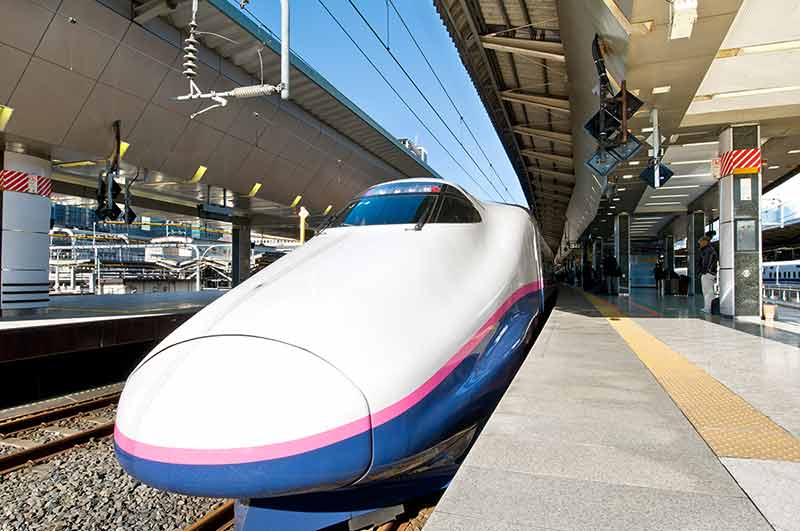
The Shinkansen is the most famous mode of transport in Japan and is more commonly referred to as the ‘bullet train’.
The Shinkansen was launched in line with the 1964 Tokyo Olympic Games, with the first journeys running between Tokyo and Osaka.
Shinkansen are high-speed trains that reach up to 320 kilometres per hour (199 miles per hour), allowing crossing the country to become quick and easy.
These fast trains operate on nine lines connecting Japan’s cities.
Bullet train lines connect Tokyo to Osaka and beyond, with trains even running to the northern reaches of Hokkaido Island.
Unlike train providers in other countries, Japan prides itself on its reliability and traveling onboard Shinkansen is no different.
The average delay time for a Shinkansen train is only 12 seconds, and trains tend to arrive and depart to the second, making them highly reliable and efficient.
The Shinkansen are also incredibly safe, with built in earthquake-safe features allowing the trains to draw power from an independent power source in the event of an outage.
13- Onsen
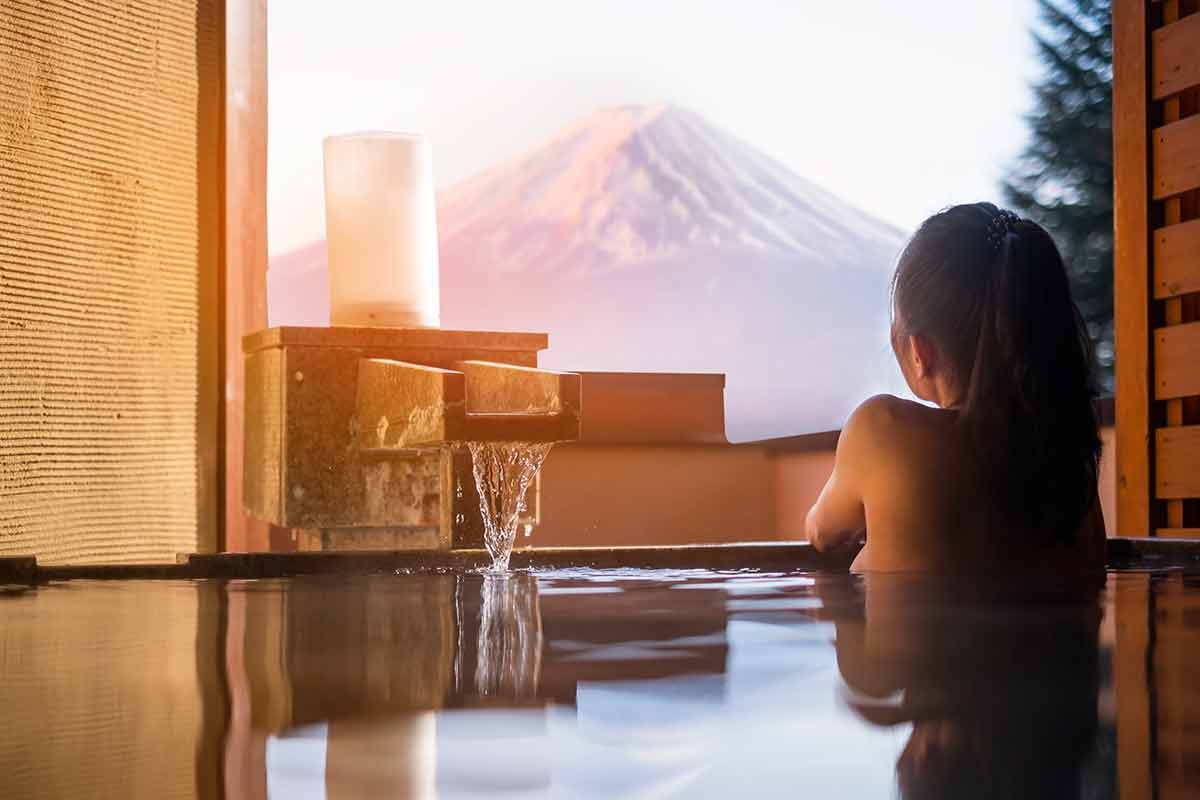
An onsen is a natural hot spring bathhouse whose waters are heated using geothermal energy from volcanic activity across Japan.
To be a true onsen, the water temperature must be 25C when it reaches the surface.
There are a number of public and private onsen’s across Japan, however to enjoy these warm waters a set of strict rules must be followed.
These rules include bathing before entering the onsen, compulsory nakedness and a ban on tattoos.
Onsen’s are considered sacred so the above rules are important in preserving this element of traditional Japanese culture.
Onsen’s are believed to have healing properties and the naturally occurring minerals in the water are said to improve skin condition and circulation.
14- Sake
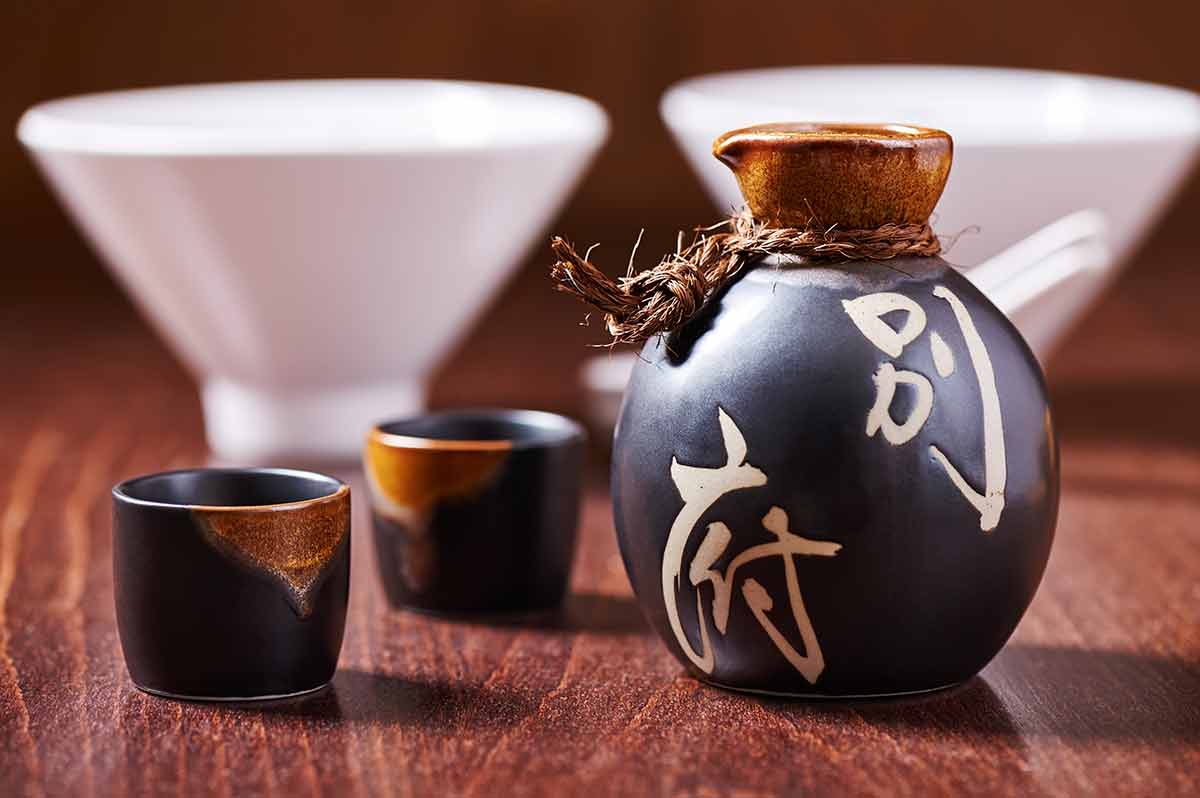
Sake is a traditional Japanese alcohol made from fermenting rice.
The drink has been brewed since the 2nd century with significant advancements in the process in the 7th century and 14th to 16th centuries.
In the late 1600s more than 27,000 sake breweries were documented across Japan.
Sake is an unusual drink in that it can taste of everything from umami flavours to fruits, can be served at a range of temperatures and is enjoyed both freshly produced and aged.
Sake also pairs well with a variety of dishes, and some restaurants offer sake pairings with meals.
Sake is available in supermarkets where different variations of the drink are offered, all with beautiful labels and some with unique bottle designs.
Recommended tour: Nagano: Snow Monkeys, Zenkoji Temple and Sake Day Trip
15- Sumo
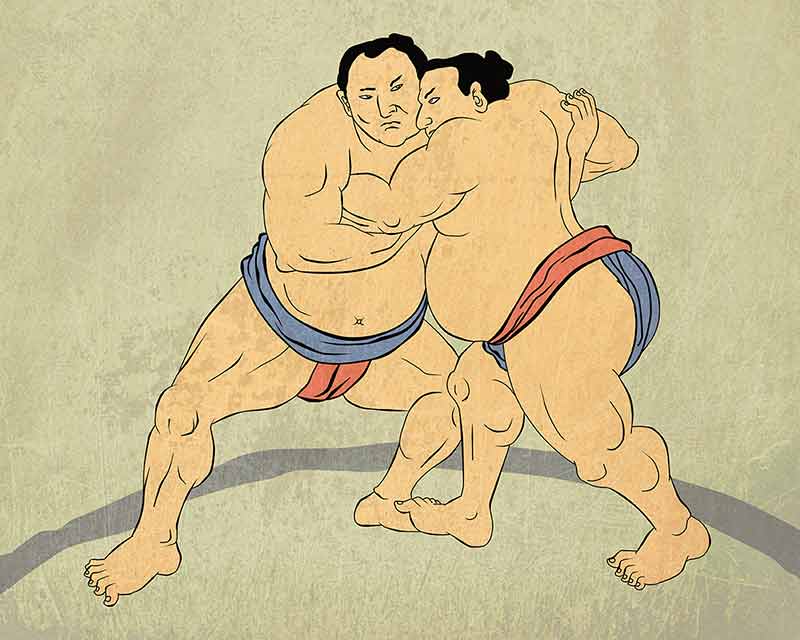
One of the most famous and most traditional practices in Japan is the art of Sumo, a competitive form of wrestling where opponents try to force their competitor out of a ring.
Sumo dates to the 700s where matches were held as a way to pray for a bountiful crop.
It wasn’t until the Edo Period that Sumo became defined by a system of clear rules and was transformed into the sport was awe see it today.
Sumo wrestlers originally took part in matches as a way to raise money for temples and shrines.
The sport has changed little since the Edo Period with wrestlers still sporting traditional top-knots, traditional dress and following a range of ancient customs when in the ring.
Sumo wrestlers begin their careers aged 15 after completing their primary education, and will live at a stable where they will sleep, eat and train until they retire at around age 30.
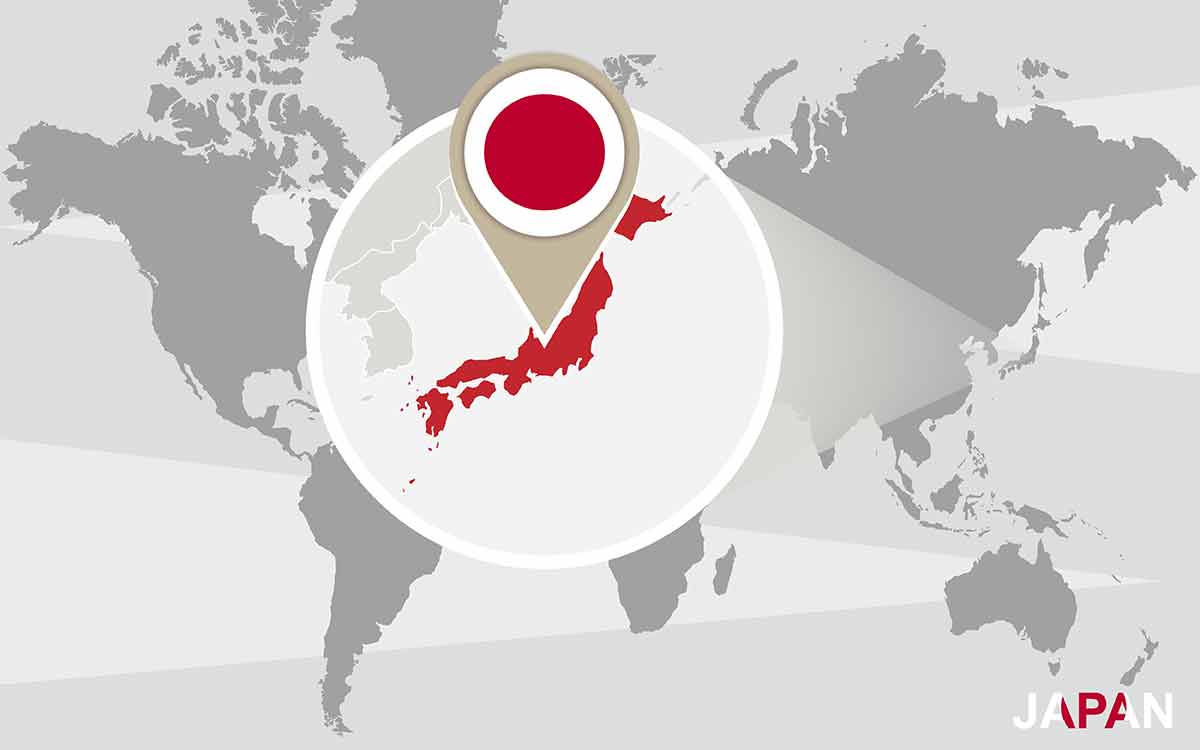
You may also be interested in:
- What is Turkey known for?
- What is Portugal known for?
- What is Greece known for?
- What is France known for?
- What is Belgium known for?
- What is Switzerland known for?
- What is Poland known for?
- What is Australia known for?
- What is Mexico known for?
- What is Germany known for?
- What is Croatia known for?
- What is Hungary known for?
- What Is Romania known for?
- What is The Netherlands known for?
- What is Scotland known for?
- What is Canada known for?
- What is Japan known for?
- What is China known for?
- What is Singapore known for?
- What is Vietnam known for?
- What is Thailand known for?
- What is Cuba known for?
- What is Argentina known for?
- What is Colombia known for?
- What is Spain known for?
- What is Italy known for?
- What is Ireland known for?
- What is Oregon known for?
- What is Colorado known for?
- What is Tennessee known for?
- What is Hawaii known for?
- What is Alabama known for?
- What is Illinois known for?
- What is Mississippi known for?
- What is Nevada known for?
- What is Maine known for?
- What is Idaho known for?
- What is Delaware known for?
- What is Maryland known for?
- What is Wisconsin known for?
- What is Miami known for?
- What is Virginia known for?
- What is West Virginia known for?
- What is Massachusetts known for?
- What is Boston known for?
- What is Florida known for?
- What is Kentucky known for?
- What is Indiana known for?
- What is Montana known for?
- What is Nebraska known for?
- What is Pennsylvania known for?
- What is Vermont known for?
- What is Arizona known for?
- What is California known for?
- What is South Carolina known for?
- What is North Carolina known for?
- What is Texas known for?
- What is Michigan known for?
- What is Ohio known for?
- What is Louisiana known for?
- What is Oklahoma known for?
- What is New York known for?
- What is Georgia known for?
- What is Utah known for?
- What is Connecticut known for?
- What is Rhode Island known for?
- What is Iowa known for?
- What Is Minnesota known for?
- What is New Hampshire known for?
- What is Arkansas known for?
- What is New Jersey known for?
- What is Missouri known for?
- What is North Dakota known for?
- What is South Dakota known for?
- What is Wyoming known for?
- What is Alaska known for?
- What is Washington known for?
- What is Seattle known for?
- What is New Mexico known for?
- What is Kansas known for?
- What is San Francisco known for?
- What is Chicago known for?
- What is Denmark known for?
- What is Norway known for?
- What is Sweden known for?
Plan Your Trip

Rent A Car – Find the best car rental rates at Discover Cars. They compare car hire companies to provide you with the best deal right now.

Find A Hotel – If you’re curious about this article and are looking for somewhere to stay, take a look at these amazing hotels.